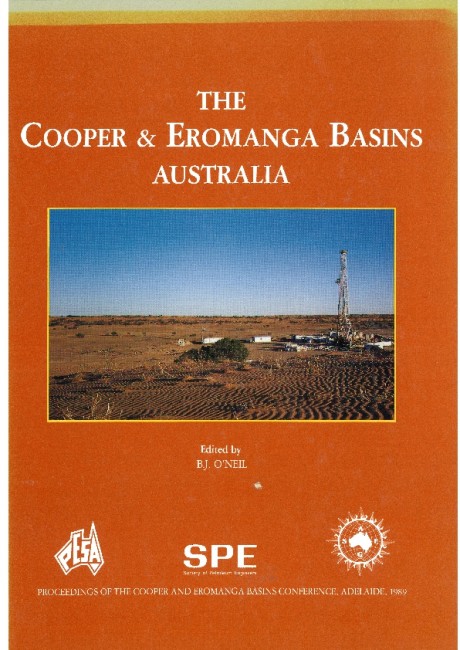Publication Name: The Cooper & Eromanga Basins Australia
Authors: B.H. Michaelsen and D.M. McKirdy
Date Published: June 1989
Number of Pages: 32
Reference Type: Book Section
Abstract:
The Murta Member (Mooga Formation) is a laterally extensive lacustrine unit, displaying some marine influencein its upper part, which was deposited across the southern Eromanga Basin under a moist cool temperate climatic regime during the Early Cretaceous. Source facies (dark grey to black silty shale; TOC = 0.5-2.5 per cent) are intercalated with thin reservoir sands which have produced hydrocarbons at flow rates up to 2180 BOPD. The unit appears to be self-sourcing. The most recent oil-source rock correlations based on alkane biomarker distributions and methylphenanthrene indices confirm that the oils are relatively immature and indigenous to the Murta Member. The gasoline-range and carbon isotopic compositions of the oils and their high content of bacterial biomarkers (notably c12+ iso- and anteiso-alkanes), highlight the significant contribution of microbial biomass to their source material. This has important implications for organic petrographic studies of the Murta shale lithofacies.
Cores of carbonaceous shale and siltstone from different facies of the Murta Member were sampled as follows: distal lacustrine (Moomba-18), intermediate lacustrine (Biala-1, Limestone Creek-6, McKinlay-2) and transitional
(Nockatunga-1,-2 and -3, Winna-1, Koora-1). Petrographicanalysis in reflected light reveals that the Murta silty shales contain dispersed organic matter (DOM) of mixed algalland plant origin, although terrestrial material is always dominant. The main macerals are inertinite (40-80 per cent ofDOM) and liptinite (15-60 per cent ofDOM). Vitrinite is a minor component (less than 10 per cent of DOM), probably because of oxidative decay of cellulose and woody tissue by aerobic bacteria. The occurrence of Botryococrusrelated telalginite, evidence of a fresh-water lacustrine to brackish-water paralic depositional environment, is ubiquitous. Visual examination of kerogen concentrates under UV irradiation (transmitted light) reveals that the liptinitic component has been significantly modified, possibly by the action of bacteria. Much of the organic material is amorphous and sporinite/cutinite exists in various stages of degradation.
Both distal and intermediate-lacustrine organic facies are marginally mature for early-phase petroleum generation where sampled and Rock-Eval pyrolysis demonstrates that the shales contain kerogen of Type II/III composition. The intermediate shales (TOC = 1-2.5 per cent; HI = 175-540; R0 = 0.5-0.6 per cent) are fair to very good potential sources of liquid hydrocarbons. However, the source potential of the distal organic facies (TOC = 1-2 per cent; HI = 125-260; Ro = 0.60-0.65 per cent) has been downgraded by the partial oxidation of algal and land
plant material prior to deposition. Within the intermediate lacustrine lithofacies along the Murteree Horst there is little systematic variation in organic facies between the shales of Mount's (1982) M1 to M5 subunits. Most are oil-prone, in contrast to the more gas-prone shales of the distal lithofacies around Moomba. The best potential source rocks, thin shale beds in the dominantly arenaceous M2 subunit, are characterised by unusually high contents of well-preserved telalginite (25-26 per cent ofDOM). Shaly intervals within the transitional lithofacies of the upper Murta Member at the eastern end of the Naccowlah Jackson Trend also contain Type II/III kerogen. Compared to their M1 equivalents in the intermediate lacustrine lithofacies, these shales display a wider range of organic richness and quality (TOC = 0.5-1.6 per cent; HI = 81-270) and are initially mature for oil generation (R0 = 0.5-0.6 per cent). Source quality is better at Nockatunga than at Koora, whereas at Winna an unusual vitrinite-rich but oil-prone organic facies is developed. For organicallylean source rocks like those of the Murta Member (TOC < 3 per cent) Rock-Eval data provide an unduly pessimistic assessment of kerogen quality and genetic potential because of the mineral matrix effect.


